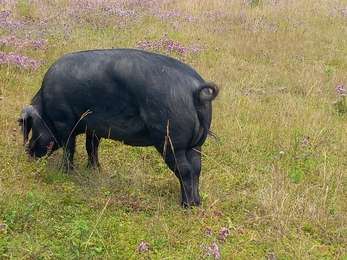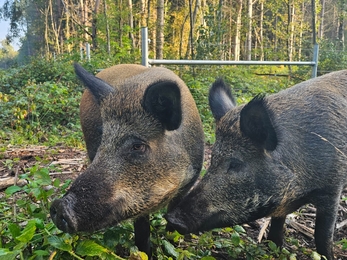Visitors will have noticed our fencing this summer as we are finishing the last stages of the fencing plan. The last step has been running a new fence along the edge of the concrete footpath up to and past the new wooden boardwalk. This has a couple of uses, one is to provide several acres of heathland free from disturbance for wildlife. The other is to provide an enclosed space for an important keystone species that would have helped manage the habitats that exist here.
Keystone species are animals that have a physical impact on the place they live, creating opportunities for other animals to live and thrive. In this instance the keystone species are two large black pigs . These pigs will carry out the job that wild boar would have done, digging holes, creating bare ground and rooting up some of the problematic plants like bracken. We are hoping that this activity will help restore areas of peatland, which have previously been lost.
The most interesting activity they carry out is called rooting. Rooting is where they use their snouts to turn over the top layer of soil looking for roots, minerals and bugs to eat. The turned over soil creates opportunity for new germinating plants, creates wet areas and pools and (of particular interest) exposes the rhizomes of bracken. The impact on bracken is the function we are most interested in. Bracken is very vigorous and has spread widely across the reserve, smothering other plants in the process, these pigs might be the way to keep it under control.
Initially we will have the pigs in a restricted area, we expect them to stay for around eight weeks, but this will depend on how they cope, what they eat and the impact they have on the site. Once they’ve returned to their permanent home (a nature reserve near Medway), we can monitor their impact and make plans for how best to use them in the future.
Isabella Tree in her book on the wilding of the Knepp estate describes pigs as ‘intelligent, inquisitive, imperious, myopic, sociable, gluttonous, grunting, ungainly, crafty, who will find a way into things,’ in short, ‘marauding ploughs’. Just two pigs will be enough to turn over or strip the soil in their fenced area here as they rootle for anything edible; beetles, roots, worms, tubers, leaves and even twigs. They will eat some of the dense invasive bracken and brambles, and the persistent or big roots of thistle, docks and sedges. Once exposed, frost will also help kill off roots they leave exposed. The apparent wreckage of rough disturbed ground left by these wandering ploughs will provide micro-climates for myriads of wildlife. Where a south-facing slope of a furrow will be favoured by some, other aspects will be favoured by other wildlife, creating mosaics of varying small habitats. Bare earth will allow less vigorous plants to germinate, dormant heather to revive, and tiny pools the size of a hoof could provide the habitat for tiny water plants such as the three lobed water crowfoot. Bare soil is needed by many invertebrates from ants to beetles and what the pigs miss, the robins and other ground feeders will soon pick up.
You can read more about how we use pigs for nature conservation here.
It is difficult to reach everybody and explain the work that Kent Wildlife Trust are carrying out. There is a lot of information on our website but If you have any questions, or would like to know more about our work, you can also contact Area Manager, Ian Rickards directly.


